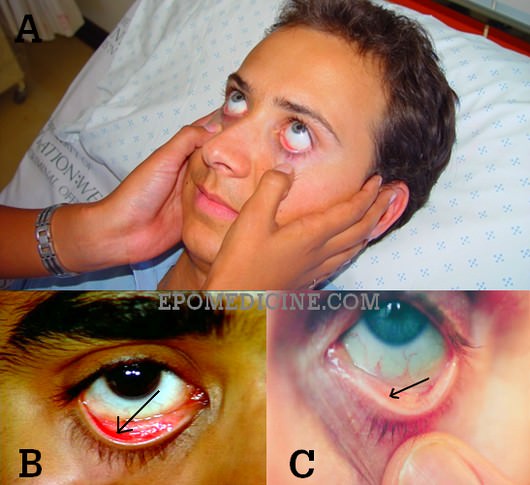Synonyms: Paleness
Definition of Pallor
Pallor is the paleness of skin and mucous membranes, due to the reduced amount of oxyhemoglobin or decreased peripheral perfusion.
Sites to look for pallor
- Lower palpebral conjunctiva
- Tip and dorsum of the tongue
- Soft palate
- Nail beds
- Palmar or plantar creases
- General body skin
Pallor in lower palpebral conjunctiva:
B. Normal conjunctiva (Note the demarcation shown by arrow)
C. Pale conjunctiva (Loss of demarcation)
How (Technique)? Pull the lower eyelid down and compare the color of anterior part of the palpebral conjunctiva (attached to the inner surface of the eyelid) with the posterior part where it reflects off the sclera. There is usually a marked difference between the distinctly red anterior and pearly white posterior parts. This difference is absent when significant anemia is present. 1Examination Medicine By Nicholas Joseph Talley, Simon O’Connor
Use both your thumb to retract eyelids downward on both the sides simultaneously and as you do so, ask the patient to look upwards.
Why(Reason)? The mucosa over this region is very thin and the underlying vessels are clearly seen and the pallor can be judged.
Pallor in palms:
How? As the patient to hyper-extend the fingers. Compare the color of palmar crease with that of the adjacent skin of palm. Pallor is said to be present if both are of same color.
Different studies showed that palmar crease pallor has high specificity for severe anemia, but sensitivity of it is low. Possibility of palmar creases to be as pale as the surrounding skin is high in fair skinned western population. In darker/more pigmented race, palmar crease pallor may be less effective as a marker of severe anemia.
Pallor in nailbeds:
How? Press the nail and note the color of nailbed after releasing the digital pressure.
Mechanism of Pallor in Anemia
Causes of pallor
1) Anemia (can be appreciated clinically when hemoglobin <8-9 g/dl)
2) Pallor without anemia:
- Physiologic (“fair skinned”)
- Shock
- Hypoglycemia and other metabolic derangements
- Respiratory distress
- Skin edema
- Pheochromocytoma
Pallor and Anemia
Although often used as synonyms, presence of pallor doesn’t always indicate anemia. Pallor is a sign, while anemia is a diagnosis based on laboratory results. Anemia is the qualitative or quantitative dimunition of RBC and/or hemoglobin concentration in relation to standard age and sex.
Clinical grading of anemia:
- Mild: Pallor of conjunctiva and/or mucous membrane
- Moderate: Above + Pallor of skin
- Severe: Above + Pallor of palmar creases
A study revealed that the presence of pallor can modestly raise the probability of severe anaemia while its absence can rule out severe anaemia. Neither presence nor absence of pallor, regardless of its severity, can accurately rule in or rule out moderate anaemia. Absence of conjunctival pallor and tongue pallor completely ruled out the probability of haemoglobin <7 g/dL. 3Kalantri A, Karambelkar M, Joshi R, Kalantri S, Jajoo U. Accuracy and Reliability of Pallor for Detecting Anaemia: A Hospital-Based Diagnostic Accuracy Study. Malaga G, ed. PLoS ONE. 2010;5(1):e8545. doi:10.1371/journal.pone.0008545.
WHO grading of anemia:
- Mild: 10 g/dl to cut off point for ages
- Moderate: 7-10 g/dl
- Severe: <7 g/dl
Hemoglobin thresholds used to define anemia:
- Men (>15 years): 13 g/dl
- Teens (12-15 years): 12 g/dl
- Women, non-pregnant (>15 years): 12 g/dl
- Women, pregnant: 11 g/dl
- Children (5-12 years): 11.5 g/dl
- Children (0.5-5 years): 11 g/dl
Variations
When assessing for pallor in darkly pigmented patients, you might experience difficulty because the underlying red tones are absent. This is significant because these red tones are responsible for giving brown or black skin its luster. The brown-skinned individual will manifest with a more yellowish brown color, and the black-skinned person will appear ashen or gray. 4Transcultural Concepts in Nursing Care edited by Margaret M. Andrews, Joyceen S. Boyle
Tips to aid assessment
Look for the coexistence of other signs, which may help to aid the diagnosis of the etiology of anemia.
- Tachycardia (Congestive Heart Failure/CHF)
- Edema (CHF, nephritic syndrome)
- Pulse volume (shock)
- Nail changes (koilonychia and paltyonychia in Iron Deficiency Anemia; splinter hemorrhages in associated thrombocytopenia)
- Skin changes (hyperpigmentation in megaloblastic anemia; petechiae in malignancies, aplastic anemia)
- Lymphadenopathy and hepatosplenomegaly (malignancy)
- Icterus (hemolytic anemia)
Special features of Anemia
Iron deficiency anemia:
- Koilonychia
- Angular stomatitis
- Glossitis
- Dysphagia
Megaloblastic anemia – Vitamin B12 deficiency:
- Subacute combined degeneration
- Peripheral neuropathy
- Severe glossitis
- Beefy-red tongue
Hemolytic anemia:
- Icterus
- Lemon-yellow color of skin
- Leg ulcers
- Splenomegaly
Thalassemia:
- Chipmunk facies
- Retarded growth
- Splenomegaly
Sickle cell anemia:
- Tower shaped skull
- Small trunk
- Long arms
- Leg ulcers
- Bony tenderness
- Osteomyelitis
- Poor growth
- Auto-splenectomy in adults
